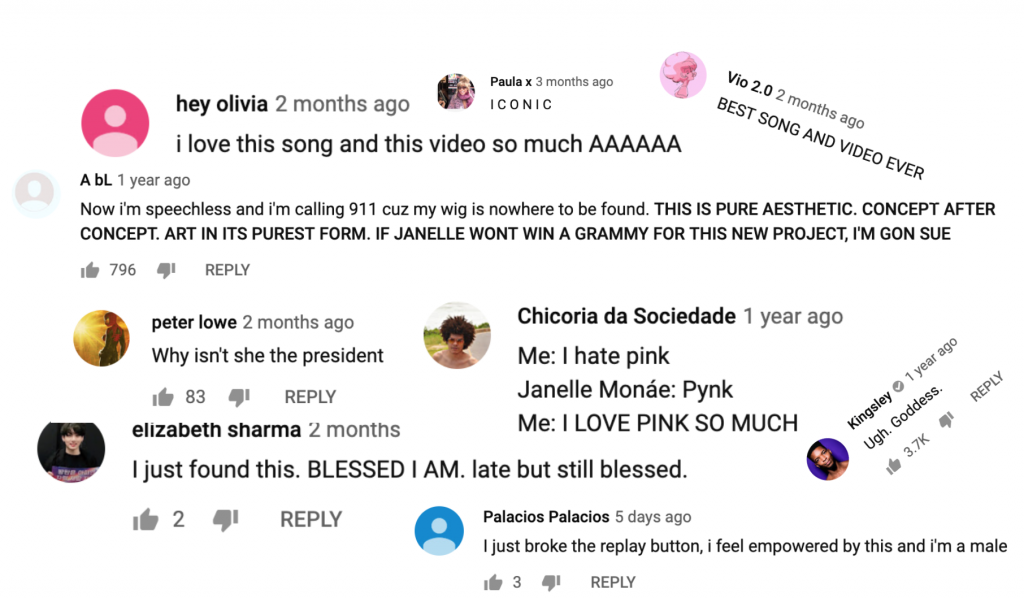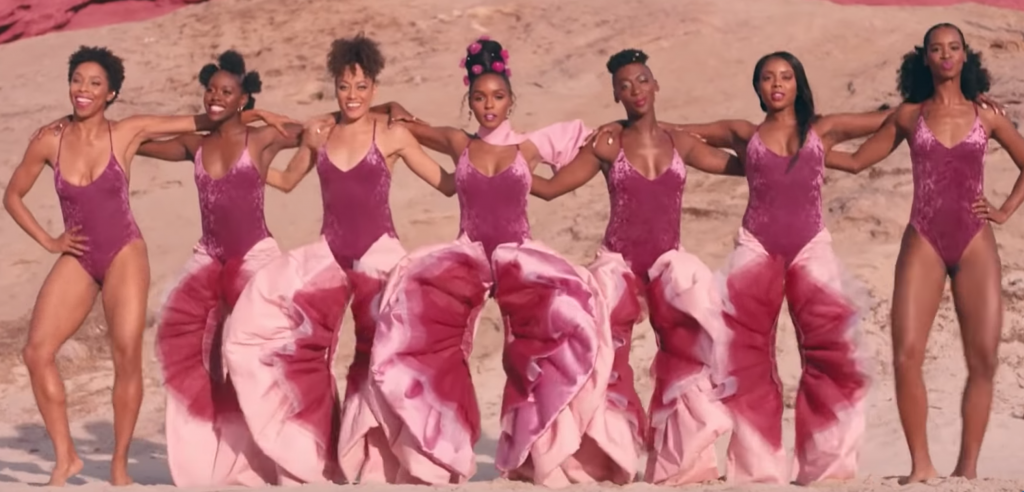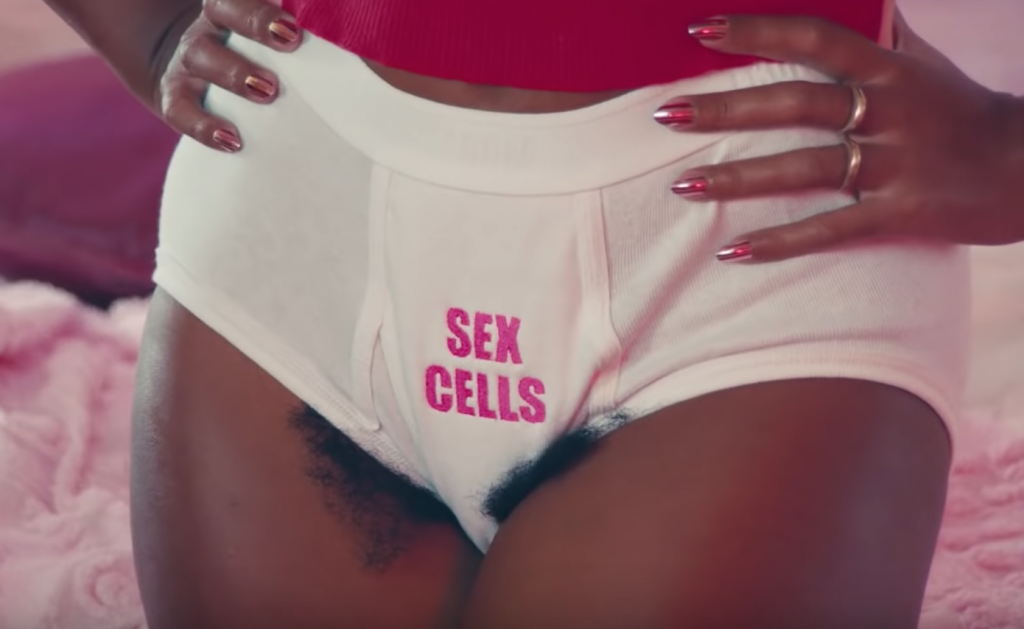So, about a year ago, Janelle Monáe blessed the world with her album Dirty Computer, which contained 14 super amazing tracks, and was also nominated for the Grammy Award Album of the Year . One of the most notable was her song PYNK:
As you can probably guess from the thumbnail, this video blew up the internet and simultaneously summoned the community of internet dwellers to emerge from the deeps of the net and provide Janelle with the worship and praise she deserves:

When discussing the nature of this song, Monáe describes something more of an anthem or manifesto rather than your generic 21st century love song, saying:
“PYNK is a brash celebration of creation. self love. sexuality. and pussy power! PYNK is the color that unites us all, for pink is the color found in the deepest and darkest nooks and crannies of humans everywhere… PYNK is where the future is born….”
The idea of the future being born with PYNK is prevalent throughout the entire music video. Right from the start, PNKY creates this futuristic and seemingly unearthly landscape: The floating car seen in the middle of an entirely pink-hued desert shows a different world where the freedom of “sexuality” and “self love” that Monáe describes is a reality, subtly implying that this pink world is what we should strive to have. Throughout the course of the video, the color transitions from the futuristic pink overlay (which symbolizes this new world) to more real world color, which implies that this “pink reality” is attainable and we are on the path towards it (but not quite there yet).
Throughout the piece, there are several visual images that create quite an impact. Most notably perhaps are the Vagina pants. These pants, whose coloring resembles the two tones that make up the labia majora and the labia minora, provide a powerful (and in the eyes of some commenters, “graphic”) visual representation of the “pink” she is singing about. It is also worth noting that everyone’s vagina pants look different: they are all different widths and sizes with different ratios of light pink to dark pink, showing that there is no one “correct” way a woman’s vagina, and by extension, a woman should look.

But, it’s not all about vagina. Like most of Monáe’s songs, the lyrics of PYNK are packed with multiple meanings. Monáe sings: “Pink like the inside of your…baby / Pink like the walls and the doors…maybe / Pink like your fingers in my…maybe / Pink is the truth you can’t hide / Pink like your tongue going round, baby” while the backup vocals reminds us that “deep inside, we’re all just pink.” So even though this song talks a lot vaginas and sex, it also focuses on the fact that in the end the other “pink” parts of a person, which Monáe mentions later in the song when she sings “Pink like the folds of your brain, crazy” and “Pynk, like the holes of your heart,” are equally as important and valued.
This song also isn’t all about female sex, from the opening line “Pink like the inside of your…baby” and when it is sung again in the second verse as “Pink like the inside of your…maybe,” Janelle Monáe acknowledges the fact that not all women have vaginas, therefore making the song about more about gender than a women’s sex. Monáe extends “pynk”-ness outside of physical genitalia, showing that being a woman and being “pynk” don’t have biological limitations. This is not only hinted at in within the lyrics, but also shown visually as two of the women are not wearing vagina pants; which really shows the incredibly amount of detail that went into crafting the subtleties of the song.
One of the most important things that PYNK does is find a way to display and celebrate female sexuality without trying to appeal to the male gaze. The male gaze, for those who are unfamiliar, is an artistic term coined by film critic Laura Mulvey to describe the depiction of women as sexual objects for the pleasure of the male viewer from the masculine, heterosexual perspective. Monáe’s depiction of women visually comes out of a desire to celebrate the beauty of all women. This idea culminates visually during the second chorus when Monáe is sporting this number:

First the pubic hair, a direct act of rebellion against the male gaze, which bolsters the ridiculous idea that in order for a woman to be most pleasing or attractive to a man she must be hairless or she is considered unattractive or undesirable. The bold hands-on-hips confident stance that Monáe has in this moment is incredibly empowering; shattering the notion that only a person who looks a certain way can be confident. Then there is the “sex cells,” a fun play on words, with “sex cells” like reproductive organs and also the fact that sex sells. Of course, last but certainly not least, their is the pink background which emcompasses the video at all times.
Like any racy and progressive music video, PYNK received its fair share of negative reactions. Some were pretty outrageous and made some outlandish accusations:


However, some people did express some alternate points of view that were more…earthly:


Although it is understandable why some people may have viewed PYNK in this way, there are several holes in these arguments that show a lack of understand of the entire concept of the video. The “too styled” and “too obvious” nature of PYNK that lisa evers complains about was the Monáe’s intent. By creating a highly stylized and obvious cinematic world, Monáe is more successfully able to exaggerate how crazy it is that we need to have music designed specifically to empower women in the first place (shouldn’t female empowerment be a given in our society?). By creating an obvious overlay, Monáe is also able to more effectively include the hidden meanings and double entendres throughout the entire piece, making them more understandable by a broader range of people (did you catch the “I grab back” @ to Donald Trump at 2:26 or all the trophies showing female athletes at 2:51?).
In response to TheBlackBird WhoAnnoyedPoe; the song and video, solely based on the fact that there is so much symbolism and is so well constructed verbally, makes it impossible for it to be “dumb,” regardless of whether or not you like the music or not. You can disagree with the concept and the execution of the video, but it technically isn’t “dumb” due to the sheer amount of intelligence needed to create symbolism in language. The point of how “men don’t going around empowering themselves in dick costumes” is a rather interesting one. Yes, that doesn’t happen in modern society, but perhaps it’s because we in exist in a world where men are born into a position of empowerment automatically and therefore these drastic measures of reclaiming the power behind their genitalia is unnecessary? This comment also highlights the stigma around genitalia that Janelle Monáe addressed through the use of her vagina pants: Why is it that a vagina is only viewed positively when it is associated with sex and male pleasure (especially in heteronormative culture)?
That is part of the beauty of Janelle Monáe’s PYNK; it addresses all of these unanswerable questions in some way shape or form. PYNK highlights powerful message of self-love, acceptance, and the embrace of female sexuality in a way that is playful and a little outlandish while still having incredible meaning and symbolism behind every choice. PYNK is an anthem for empowerment, an song to inspire and celebrate women in modern day society.
PYNK Fun Fact courtesy of the internet:

#1 Best PYNK Video Comment:


I love your blogpost! You did a great job of explaining the imagery of this video, and I love how you went into detail about how not every woman looks the same. Very empowering, and definitely did a great job at capturing the female empowerment message Janelle Monae was trying to show to everyone. The reactions to this song/video you included added a lot more personality to it, showing the side of depth, meaning, and female empowerment, as well as showing the people (mostly men) who seemed too intimidated by the video and thought that it was too shallow or something. I would have loved to see commentary from Janelle in an interview setting or even on social media, just to see how she reacts to her listeners reactions, and maybe also tying in one or two of her other songs that showcase female empowerment to strengthen your argument of this song. But such a beautiful job!